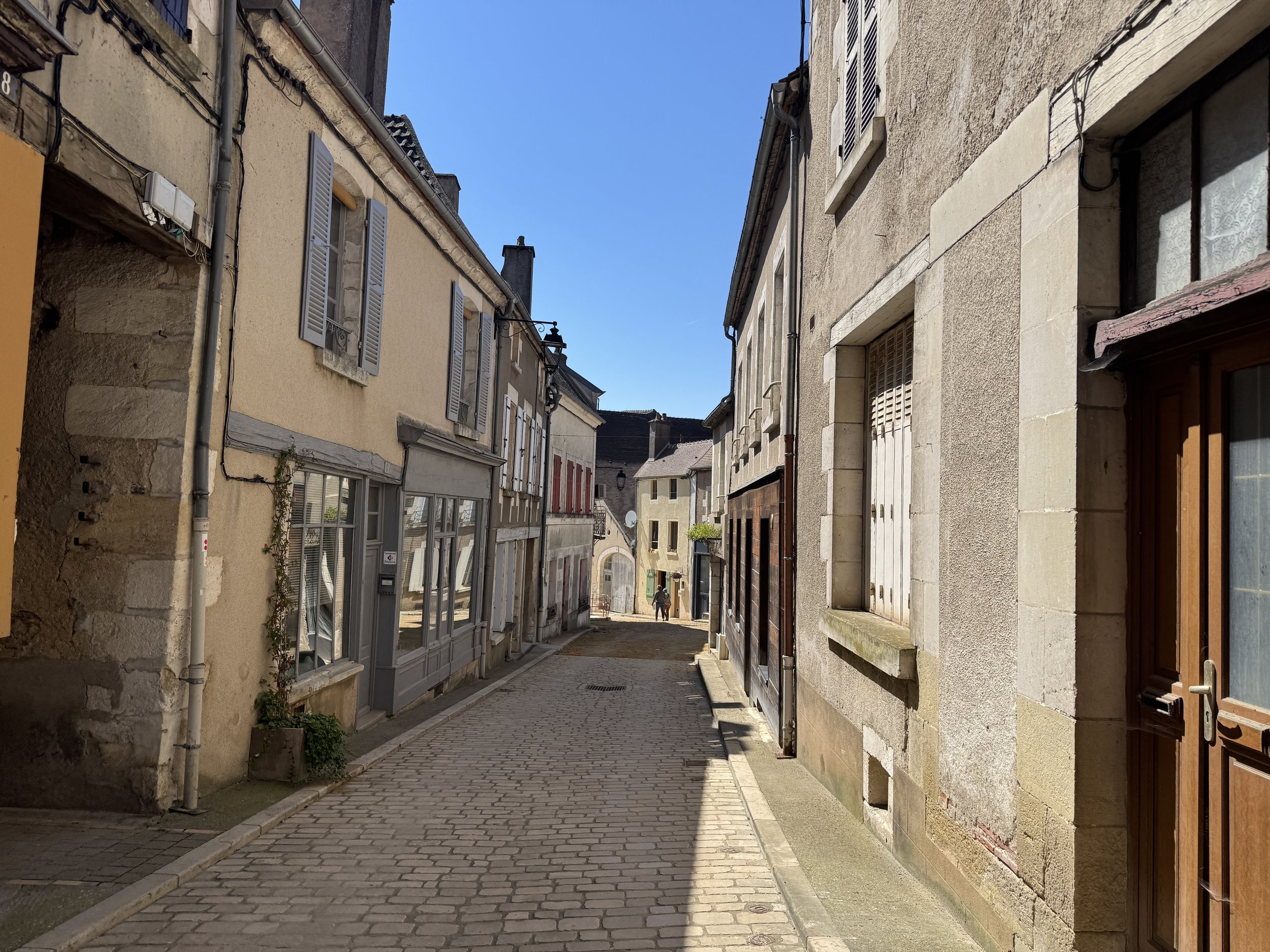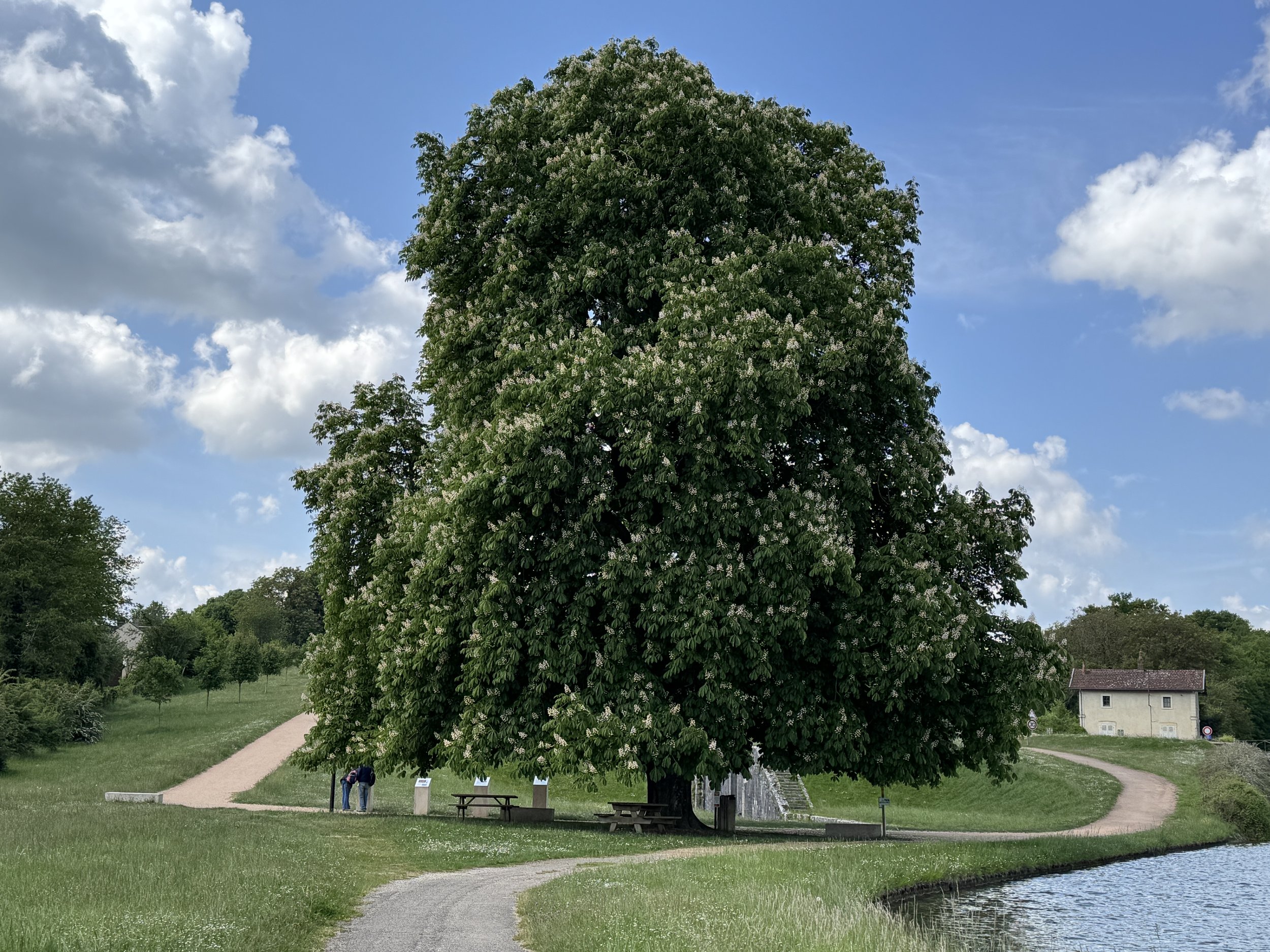The Last of the Loire
We awoke in the shade of the trees in San Thibault on a very warm morning and prepped to hike up to Sancerre, a medieval hilltop village overlooking the Loire valley and known for its wine. The slopes are blanketed by vineyards.
The town sprang up around a medieval castle that was once one of the region's most prominent châteaus. The castle keep, known as the Tour des Fiefs, is a 14th-century relic that was once part of the feudal castle of the Counts of Sancerre.










Sancerre vineyards date back to Roman times. A port called Gorton was created on the banks of the Loire, near the location of the contemporary town of San Thibault (where we had left Meraki), local wines and other goods could easily be shipped to all corners of the territory from there.
Monks were active in winemaking in the region during the Middle Ages, those living nearby were quite possibly the first to plant Burgundy Pinot Noir in the sixteenth century. Sancerre was mostly a red wine region before the phylloxera outbreak, a tiny microscopic insect which destroyed the vineyards in the nineteenth century. When it came to vineyard restoration however, a disease-resistant Sauvignon blanc was chosen.
Contrary to many white wines, Sancerre wines typically have lower sugar content. This reduced sugar level gives Sancerre a distinctly dry character, distinguishing it from other sweeter white wines. It’s crisp and fruity and has a kind of zesty flavor.
We were introduced to Pouilly-Fumé the day before (by Captain Chris who had left the marina in his 125 year old barge a day earlier). It is a dry, white wine made entirely from the Sancerrre Sauvignon Blanc grapes and has a mineral and smoky flavor.

















The next day started off like any other but quickly took a turn. I was standing out on the bow enjoying the sun when we came around a bend in the river and I saw a man fishing - he had three lines in the water. We waved to each other and he gestured that we should move to the far side of the canal. I told Tom the man’s lines were still in the water (usually they pull them out as a boat approaches) and he wanted us to move over. Tom moved us over as far as we could in the shallow canal and the man smiled and gave us a thumbs up. As we got closer however, he seemed agitated and shouted something in French and signaled again more frantically that we needed to move over. I yelled back that our boat draft is 1.5 meters and that there wasn’t enough water to move over any further (this is a topic I am now quite proficient at discussing in French). But he was not happy. At this point we were just crossing his lines and one of the three got cut by our props. I shouted an apology and shrugged, but he became irate — screaming what I could only surmise was a barrage of curses. I felt badly we’d disturbed his fishing but wondered why he’d not just reeled his lines out of the channel like all other fisherman.
Super crazy, angry dude!
I relaxed on the bow once again and we continued along the canal. A few minutes later we rounded a bend in the river and the same man ran out from behind some trees with a slingshot and began shooting at me! Evidently he had jumped in his car and driven upstream where he’d stopped to wait for us. Lead fishing weights were whizzing by my head and bouncing off Meraki’s windows, walls and hull! I ran to the back of the boat and threw my arms in the air in utter disbelief while he continued to shoot at me until we were out of range. It was alarming and horrifying. We motored on, though for the next many kilometers I nervously wondered if he might jump out of the bushes again. It took some time before we both started to calm down. We rather abruptly had came to the realization that we’d felt completely trapped - literally the definition of a sitting duck. There is no where to go on the canals if someone loses their temper and comes after you. Sadly, this set the tone for the entire rest of the day. We were both lost in our own thoughts when we arrived at our stop for the night.
We spent the evening settling our nerves, the next morning declaring we would have a mellower day. The countryside rolled by lazily and we slowly relaxed back into river-cruising mode. We tied up for the night, after just a couple of hours, in Belleville, a charming little village surrounded by wheat fields and sunflowers. It was a newer, more modern port with a couple of cafes, restaurants, beautiful gardens and, of course, a Boulangerie. We took a stroll around town and caught up on chores.











We started the day with a quick stop at the Boulangerie - it had to be done! And then motored further down the waterway for a couple of hours. We called it a day at a quiet bend in the river with no other boats around. We love the fact that we don’t need electricity and can just hammer a stake in the ground anywhere along the bank that parking is permitted.









We arrived in the town of Briare around noon the next day and crossed the famous Briare Aqueduct which carries the Canal latéral à la Loire over the Loire River on its journey to the Seine.
This aqueduct is one of the oldest in France and was designed by Gustave Eiffel and built by the Eiffel Company between 1890 and 1896. The aim was to enable the Loire River to be crossed by barges and to link the Saône and Seine basins. The bridge is 662 meters (nearly ½ mile) in length and is suspended 11 meters (36 feet) above the river. The Briare Aqueduct was until recently the longest navigable aqueduct in the world.




We tied up in an open space against the wall at the port of Briare. There is a lovely marina in Briare but the upper section is the only area with enough water for Meraki and it happened to be full. We planned to spend several days there in preparation for more guests, Tom’s sister and her wife would be joining us for a few days in the middle of their 5 week adventure through Europe.
Tied onto a barge
The night before our company arrived we were approached by the captain of a hotel barge. Apparently we were tied up in the space he’d reserved for the night. He needed us, along with one other pleasure boat, to move out of the way. The only available space for us was alongside a large barge already moored along the wall. Rafting up to another boat is fairly common though we’d never done it before. We moved beside the barge and tied onto it. We now needed to cross their deck to get on and off Meraki. Thankfully the barge owner was friendly and not at all bothered or concerned by us.














We picked up our guests at the train station and filled them in on life aboard and the plan for the next few days - we would be doing LOTS of locks. The 57km (35 mile) Canal de Briare rises through 12 locks before falling through another 24. The locks in this section were automatic, controlled by a lock-keeper and operate in a series of three chains.
Although there were already canals in existence in Europe, the Canal de Briare was the first one to cross a watershed, and it was therefore necessary to provide locks and a means to feed water into them. Artificial lakes were constructed at the top of the rise, and at the town of Rogny, the steepest section, a staircase of seven locks was built. The difficulty with this was that each boat had to pass through all seven locks before another one could start, the result being huge delays and the system was eventually bypassed.
We stopped for lunch in what is now known as the town of Rogny-les-Sept-Écluses. Here the canal leaves the valley of the Loire River, climbing to it’s highest point before descending into the Loing valley. We had now crossed our final elevation gain, from here on we would be moving downstream, locking down towards the Seine River and on to the sea.











We were now on the Canal du Loing. Here the locks are automatic and operated by a handheld control unit which I was given at the first one. Thankfully the printed instructions were in english and I quickly got the hang of it. Press one button when approaching the lock, indicate which direction we’re going - upstream or downstream, then another button once the boat is secure, then begin lockage. The gates behind us would close, the sluices open automatically, the water level dropped ever so slowly, and when the gates in front of us opened the unit would tell us to exit.
The days passed lazily, stopping for lunch and tying up at night in small villages or quiet nature haltes, taking walks around town, visiting the Boulangeries. One night we spent in a nature halte adjacent to a couple of large lakes. In front of us sat a gorgeous old dutch barge, built in 1925, which had been restored to perfection. It is a former sailing ship with a flat bottom - the mast and the leeboards still bear witness to that. Today there is an engine that provides the propulsion, but steering is still done with a tiller.
We met the lovely Belgian couple living aboard who invited us over for aperitifs that night. We were taken by their ‘joie de vivre’ - their simple joy at embracing life in a loving, light-hearted and spirited way.















Our final night together was spent along the banks in the town of Montbouy. We meandered the streets, stopping in shops and observing the local wildlife. We would be dropping off our guests the next evening in Montargis where they would continue their European adventure. We love having people along on our travels. Life on the French Canals appeals to the imagination and continues to be an adventure every day.













Note: Photo captions will not appear if viewing on a cell phone.







